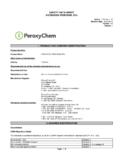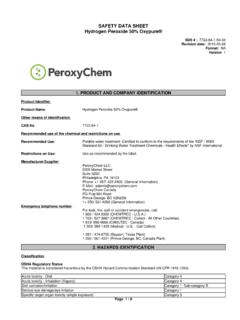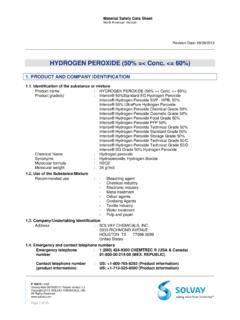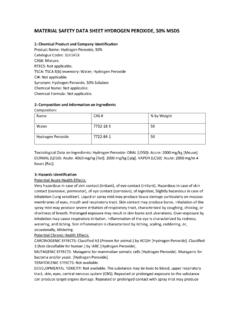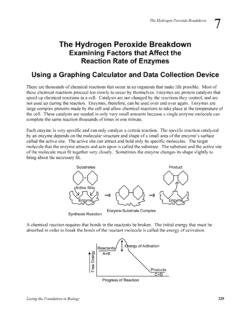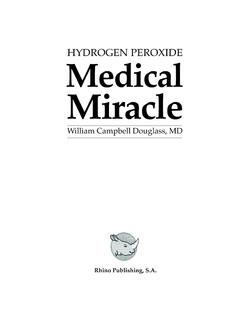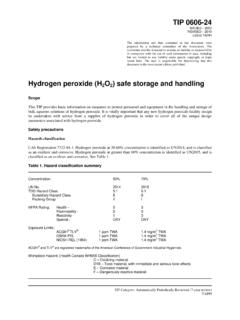Transcription of SAFETY DATA SHEET HYDROGEN PEROXIDE 35% - H2O2
1 SAFETY data SHEETHYDROGEN PEROXIDE 35%SDS # : 7722-84-1--35 Revision date: 2015-03-18 Format: NAVersion 11. PRODUCT AND COMPANY IDENTIFICATIONP roduct Identifier Product NameHYDROGEN PEROXIDE 35%Other means of identification CAS-No7722-84-1 Recommended use of the chemical and restrictions on use Recommended Use:Restrictions on Use:Use as recommended by the PeroxyChem LLC2005 Market StreetSuite 3200 Philadelphia, PA 19103 Phone: +1 267/ 422-2400 (General Information)E-Mail: CanadaPG Pulp Mill RoadPrince George, BC V2N2S61+ 250/ 561-4200 (General Information)Emergency telephone number For leak, fire, spill or accident emergencies, call:1 800 / 424 9300 (CHEMTREC - )1 703 / 527 3887 (CHEMTREC - Collect - All Other Countries)1 613/ 996-6666 (CANUTEC - Canada) 1 303/ 389-1409 (Medical - - Call Collect)1 281 / 474-8750 (Bayport, Texas Plant)1 250 / 561-4221 (Prince George, BC, Canada Plant)2.
2 HAZARDS IDENTIFICATIONC lassification OSHA Regulatory StatusThis chemical is considered hazardous by the 2012 OSHA Hazard Communication Standard (29 CFR ).Acute toxicity - OralCategory 4 Acute toxicity - Inhalation (Vapors)Category 4 Skin corrosion/irritationCategory 2 Sub-category BSerious eye damage/eye irritationCategory 1 Page 1 / 9 HYDROGEN PEROXIDE 35%SDS # : 7722-84-1--35 Revision date: 2015-03-18 Version 1 Specific target organ toxicity (single exposure)Category 3 GHS Label elements, including precautionary statements EMERGENCY OVERVIEWP recautionary Statements - PreventionP271 - Use only outdoors or in a well-ventilated areaP261 - Avoid breathing mist/vapors/sprayP280 - Wear protective gloves/ protective clothing/ eye protection/ face protectionP210 - Keep away from heat/sparks/open flames/hot surfaces. - No smokingP221 - Take any precaution to avoid mixing with combustibles/flammablesP220 - Keep/Store away from clothing/flammable materials/combustiblesPrecautionary Statements - ResponseP305 + P351 + P338 - IF IN EYES: Rinse cautiously with water for several minutes.
3 Remove contact lenses, if present and easy todo. Continue rinsingP310 - Immediately call a POISON CENTER or doctorP302 + P352 - IF ON SKIN: Wash with plenty of water and soapP332 + P313 - If skin irritation occurs: Get medical advice/ attentionP362 + P364 - Take off all contaminated clothing and wash it before reuseP304 + P340 - IF INHALED: Remove person to fresh air and keep comfortable for breathingP312 - Call a POISON CENTER or doctor if you feel unwellP301 + P312 - IF SWALLOWED: Call a POISON CENTER or doctor if you feel unwellP330 - Rinse mouthP370 + P378 - In case of fire: Use water for extinctionHazards not otherwise classified (HNOC) No hazards not otherwise classified were Information Keep container in a cool place out of direct sunlight. Store only in vented containers. Do not store on wooden pallets. Do not returnunused material to its original container.
4 Avoid contamination - Contamination could cause decomposition and generation ofoxygen which may result in high pressure and possible container rupture. Empty drums should be triple rinsed with water LiquidsCategory 2 DangerHazard StatementsH318 - Causes serious eye damageH302 - Harmful if swallowedH332 - Harmful if inhaledH335 - May cause respiratory irritationH315 - Causes skin irritationH270 - May cause or intensify fire; oxidizerPage 2 / 9 HYDROGEN PEROXIDE 35%SDS # : 7722-84-1--35 Revision date: 2015-03-18 Version 14. FIRST AID MEASURESEye ContactRinse immediately with plenty of water, also under the eyelids, for at least 15 contact lenses, if present, after the first 5 minutes, then continue rinsing. Seekimmediate medical ContactTake off contaminated clothing. Rinse skin immediately with plenty of water for 15-20minutes. Call a poison control center or doctor for further treatment to fresh air.
5 If person is not breathing, contact emergency medical services, then giveartificial respiration, preferably mouth-to-mouth if possible. Call a poison control center ordoctor for further treatment mouth. Do not induce vomiting. If conscious, give 2 glasses of water. Get immediatemedical attention. Never give anything by mouth to an unconscious important symptoms andeffects, both acute and delayedIn case of accidental ingestion, necrosis may result from mucous membrane burns (mouth,esophagus and stomach). Oxygen rapid release may cause stomach swelling andhemorrhaging, which may product major, or even fatal, injury to organs if a large amounthas been case of skin contact, may cause burns, erythema, blisters or even necrosis. HydrogenPeroxide irritates respiratory system and, if inhaled, may cause inflammation andpulmonary edema. The effects may not be of immediate medicalattention and special treatmentneeded, if necessaryHydrogen PEROXIDE at these concentrations is a strong oxidant.
6 Direct contact with the eyeis likely to cause corneal damage especially if not washed immediately. Carefulopthalmologic evaluation is recommended and the possibility of local corticosteroid therapyshould be considered. Because of the likelihood of corrosive effects on the gastrointestinaltract after ingestion, and the unlikelihood of systemic effects, attemps at evacuating thestomach via emesis induction or gastric lavage should be avoided. There is a remotepossibility, however, that a nasogastric or orogastric tube may be required for the reductionof severe distension due to gas FIRE-FIGHTING MEASURESS uitable Extinguishing MediaWater. Do not use any other Hazards Arising from theChemicalIn closed unventilated containers, risk of rupture due to the increased pressure fromdecomposition. Contact with combustible material may cause fireHazardous Combustion ProductsOn decomposition product releases oxygen which may intensify data Sensitivity to Mechanical ImpactNot to Static DischargeNot equipment andprecautions for firefightersUse water spray to cool fire exposed surfaces and protect personnel.
7 Move containers fromfire area if you can do it without risk. As in any fire, wear self-contained breathing apparatusand full protective ACCIDENTAL RELEASE MEASURES3. COMPOSITION/INFORMATION ON INGREDIENTSF ormulaHO - OHChemical nameCAS-NoWeight % HYDROGEN peroxide7722-84-135 Water7732-18-565 Occupational exposure limits, if available, are listed in section 8 Page 3 / 9 HYDROGEN PEROXIDE 35%SDS # : 7722-84-1--35 Revision date: 2015-03-18 Version 1 Personal PrecautionsAvoid contact with skin, eyes and clothing. Wear personal protective equipment. Isolate andpost spill area. Keep people away from and upwind of spill/leak. Eliminate all sources ofignition and remove combustible materials exposed to HYDROGEN PEROXIDE should be immediately submerged inor rinsed with large amounts of water to ensure that all HYDROGEN PEROXIDE is HYDROGEN PEROXIDE that is allowed to dry (upon evaporation HYDROGEN PEROXIDE canconcentrate) on organic materials such as paper, fabrics, cotton, leather, wood or othercombustibles can cause the material to ignite and result in PrecautionsDo not flush into surface water or sanitary sewer system; if discharged into sewers orwatercourses, dilute with plenty of water.
8 See Section 12 for additional for ContainmentDike to collect large liquid spills. Stop leak and contain spill if this can be done safely. Smallspillage: Dilute with large quantities of for cleaning upFlush area with flooding quantities of water. HYDROGEN PEROXIDE may be decomposed byadding sodium metabisulfite or sodium sulfite after diluting to about 5%.7. HANDLING AND STORAGEH andlingKeep/Store away from clothing/ combustible materials. Wear personal protectiveequipment. Reference to other sections. Never return unused HYDROGEN PEROXIDE to originalcontainer. Contamination may cause decomposition and generation of oxygen gas whichcould result in high pressures and possible container rupture. Empty drums should be triplerinsed with water before discarding. Utensils used for handling HYDROGEN PEROXIDE shouldonly be made of glass, stainless steel, aluminum or plastic.
9 Pipes and equipment should bepassivated before first use. Use only in well-ventilated areas. HYDROGEN PEROXIDE should bestored only in vented containers and transferred only in a prescribed containers in cool areas out of direct sunlight and away from combustibles. Providemechanical general and/or local exhaust ventilation to prevent release of vapor or mist intowork environment. Containers must be vented. Keep/store only in original container. Storerooms or warehouses should be made of non-combustible materials with impermeablefloors. In case of release, spillage should flow to safe area. Containers should be visuallyinspected on a regular basis to detect any abnormalities (swollen drums, increases intemperature, etc.).Incompatible products Combustible materials. Copper alloys, galvanized iron. Strong reducing agents. Heavymetals. Iron.
10 Copper alloys. Contact with metals, metallic ions, alkalis, reducing agents andorganic matter (such as alcohols or terpenes) may produce self-accelerated EXPOSURE CONTROLS/PERSONAL PROTECTIONC ontrol parameters Exposure GuidelinesIngredients with workplace control nameACGIH TLVOSHA PELNIOSHM exicoHydrogen PEROXIDE 7722-84-1 TWA: 1 ppmTWA: 1 ppmTWA: mg/m3 IDLH: 75 ppmTWA: 1 ppmTWA: mg/m3 Mexico: TWA 1 ppmMexico: TWA mg/m3 Mexico: STEL 2 ppmMexico: STEL 3 mg/m3 Chemical nameBritish ColumbiaQuebecOntario TWAEVA lbertaHydrogen PEROXIDE 7722-84-1 TWA: 1 ppmTWA: 1 ppmTWA: mg/m3 TWA: 1 ppmTWA: 1 ppmTWA: mg/m3 Appropriate engineering controlsPage 4 / 9 HYDROGEN PEROXIDE 35%SDS # : 7722-84-1--35 Revision date: 2015-03-18 Version 1 Engineering measuresEnsure that eyewash stations and SAFETY showers are close to the workstation adequate protection measures, such as personal protective equipmentEye/Face ProtectionUse chemical splash-type monogoggles and a full-face shield made of polycarbonate,acetate, polycarbonate/acetate, PETG or and Body ProtectionFor body protection wear impervious clothing such as an approved splash protective suitmade of SBR rubber, PVC (PVC Outershell w/Polyester Substrate), Gore-Tex (Polyestertrilaminate w/Gore-Tex), or a specialized HAZMAT Splash or Protective Suite (Level A, B,or C).
